https://www.dekitabi.com/itinerary/hikone-essential-tour
Nestled along the shores of Lake Biwa in Shiga Prefecture, Hikone is a city rich in history and culture. This charming locale boasts several significant landmarks that attract history enthusiasts and casual tourists alike. From the majestic Hikone Castle to the serene Genkyuen Garden, and from the historical Hikone Castle Museum to the evocative ruins of Sawayama Castle, Hikone offers a diverse array of experiences. Let’s delve into the highlights of this captivating city.
Hikone Castle: A National Treasure

https://www.dekitabi.com/attraction/hikone-castle
Hikone Castle is one of the few remaining original castles in Japan, dating back to the early 17th century. This well-preserved fortress is a National Treasure, renowned for its architectural beauty and historical significance. As you approach the castle, you’ll be greeted by its imposing three-story keep, which stands as a testament to Japan’s feudal past. The keep offers panoramic views of Lake Biwa and the surrounding city, making it a perfect spot for photography.
The castle grounds are equally impressive, featuring a variety of gates, turrets, and stone walls that showcase the defensive strategies of the Edo period. The Ninomaru-Sawaguchi Tamon Yagura, a long corridor turret, is particularly noteworthy. Walking through these ancient structures, visitors can imagine the bustling activity of samurai and retainers who once lived here.
Hikone Castle Museum: A Glimpse into the Past

https://www.dekitabi.com/attraction/hikone-castle-museum
Located within the castle grounds, the Hikone Castle Museum offers an in-depth look at the region’s history. The museum is housed in a former palace building that served as the residence for the Ii family, the feudal lords of Hikone. The exhibits include samurai armor, weapons, traditional clothing, and various artifacts that provide insight into the daily life and culture of the Edo period.
One of the museum’s highlights is the collection of Noh masks and costumes, reflecting the rich tradition of Noh theater patronized by the Ii family. Additionally, the museum’s gardens, with their meticulously manicured landscapes and tranquil ponds, offer a peaceful retreat and a glimpse into the aesthetic sensibilities of the period.
Genkyuen Garden: A Haven of Tranquility

https://www.dekitabi.com/attraction/genkyuen
Adjacent to Hikone Castle, Genkyuen Garden is a picturesque Japanese landscape garden that epitomizes the beauty and tranquility of traditional Japanese garden design. Created in the late 17th century by the fourth lord of Hikone, Ii Naooki, the garden was designed for the enjoyment of the feudal lords and their guests.
Genkyuen features a large central pond, symbolizing Lake Biwa, surrounded by winding paths, lush greenery, and charming tea houses. Visitors can stroll along the pathways, crossing stone bridges and admiring the seasonal flowers that change throughout the year. In autumn, the garden is particularly stunning, with vibrant maple trees reflecting in the calm waters of the pond.
Yumekyobashi Castle Road: A Step Back in Time

https://www.dekitabi.com/attraction/yume-kyobashi-castle-road
Yumekyobashi Castle Road offers a nostalgic journey through Japan’s past, with its streets lined with traditional Edo-period architecture. This charming road is a recreation of an old castle town, complete with merchant houses, craft shops, and eateries that transport visitors back to the days of the samurai.
As you wander down Yumekyobashi Castle Road, you’ll find an array of shops selling local crafts, souvenirs, and delicious snacks. Be sure to try the local specialty, “Hikone beef,” known for its rich flavor and tenderness. The road also features historical displays and information boards that provide context about the area’s history and cultural significance.
Ryotanji Temple: A Spiritual Sanctuary

https://www.dekitabi.com/attraction/ryotanji-temple-shiga
Ryotanji Temple, located a short distance from Hikone Castle, is a serene Buddhist temple with a history dating back over 1,400 years. The temple is associated with the Ii family, who were devout patrons and contributed to its development. Ryotanji is renowned for its beautiful Zen garden, designed by the famous landscape architect Kobori Enshu.
The garden’s design incorporates natural elements like rocks, sand, and carefully pruned trees to create a sense of harmony and balance. The temple’s main hall houses several important cultural properties, including statues and scrolls. Visitors can also participate in Zen meditation sessions, offering a chance to experience the spiritual tranquility that the temple embodies.
Sawayama Castle Ruins: Echoes of the Past

https://www.dekitabi.com/attraction/sawayama-castle-ruins
The Sawayama Castle Ruins offer a poignant glimpse into the tumultuous history of the region. Originally built in the late 16th century by Ishida Mitsunari, a prominent samurai and military commander, Sawayama Castle played a significant role during the Sengoku period. The castle was later taken over by the Ii family after Mitsunari’s defeat at the Battle of Sekigahara.
Today, the ruins of Sawayama Castle are a popular hiking destination, offering scenic views of Hikone and Lake Biwa. The site is dotted with remnants of stone walls and foundations, evoking the once-grand structure that stood here. Interpretive signs provide historical context, making it a rewarding visit for history buffs and nature lovers alike.
Conclusion
Hikone is a city where history comes alive through its well-preserved castles, serene gardens, and evocative ruins. Each landmark offers a unique window into Japan’s rich cultural heritage, providing visitors with a deeper understanding of the nation’s past. Whether you’re exploring the majestic Hikone Castle, strolling through the tranquil Genkyuen Garden, or reflecting at the Sawayama Castle Ruins, Hikone promises an enriching and unforgettable experience. This journey through time is a testament to the enduring allure of Japan’s historical treasures.


Leave a Reply